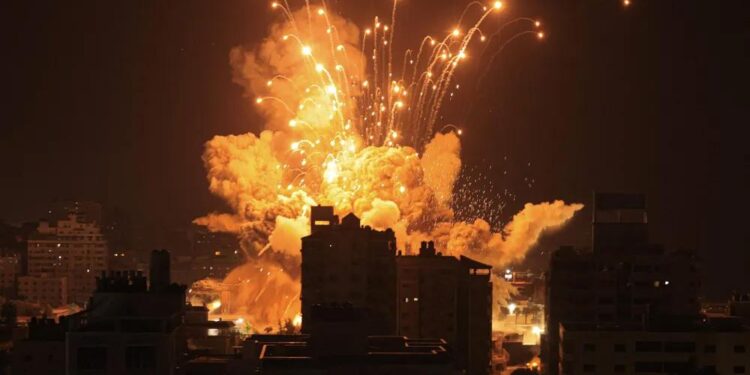Saturday the world was rocked by the outbreak of war in southern Israel as Hamas fighters crossed out of Gaza, taking hostages and killing Israeli civilians. The political leader of Hamas says the attacks were in response to the Israeli treatment of Palestinians at the al-Aqsa Mosque last week. But other reports indicate that the attack was planned for weeks with the help of the Iranian government and was meant to mark the fiftieth anniversary of the Yom Kippur War.
Over nine hundred Israelis and fourteen American citizens are confirmed dead as of this writing. Music festival attendees and members of a tiny farming community were massacred. Over a hundred Israelis and some Americans were taken captive and brought back into Gaza.
In response, Israel formally declared war and ordered the largest call-up of reservists in the country’s history. On Monday, Israel’s defense minister announced a “complete siege” of Gaza. “There will be no electricity, no food, no fuel, everything is closed. We are fighting human animals and we will act accordingly.”
The Israeli air force began firing at targets within Gaza shortly after the attack. As of Tuesday, the strikes have killed over eight hundred people, including dozens of children. One family lost thirteen members, four of whom were toddlers when their apartment building was hit. On Monday, a Hamas spokesman threatened to broadcast the execution of an Israeli hostage for every unannounced strike, saying, “The enemy does not understand the language of humanity and morals, so we will address him in the language he knows.”
Coverage of war is often intense and emotional, especially when developments are fresh. That is, of course, because the healthy human reaction is to be horrified and angered by reports and footage of people being slaughtered, captured, or forced to flee for their lives.
War is no trivial subject. It’s violence on the widest scale. At their best, wars can throw off the worst tyrannies and liberate the oppressed. But they can also bring about the worst atrocities.
That’s why it is so important to have a firm and precise understanding of when violence is justified. History shows that without this it is far too easy for our healthy human reactions and emotions to be funneled into support for further crimes—trapping us in indiscriminate revenge cycles.
The best outline of when violence is justified in the context of war is Murray Rothbard’s 1963 essay “War, Peace, and the State.” In it, Rothbard shows that the difference between war and all other questions of crime and punishment is simply a matter of scale. Therefore, the general prohibition on invading the persons or property of innocent people is still at play and must be considered absolute.
Everyone is justified in resisting or repelling any invasion of their person or property; extracting restitution or exacting punishment in response to an invasion; or helping someone else do the same. However, as Rothbard lays out, one of the most important concepts that often gets lost or forgotten in the fog of war is that violence may only be used to resist or punish the aggressor. Any violence committed against an innocent third party in response to a crime is itself a new crime:
If Jones finds that his property is being stolen by Smith, he has the right to repel him and try to catch him; but he has no right to repel him by bombing a building and murdering innocent people or to catch him by spraying machine gun fire into an innocent crowd. If he does this, he is as much (or more of) a criminal aggressor as Smith is.
The fact that wars are often fought between groups does not change the fact that attacking innocent people is a crime. But even if one doesn’t care about the rights of people in the vicinity of the enemy, attacking them is a bad strategy.
Killing someone’s friends and family motivates them to fight back—not roll over and put down their weapons. That can be seen in the West’s reactions to the Hamas soldiers’ slaughter of Israeli civilians. They want blood. Maybe people on the other side feel that way too.
That tragic cycle of indiscriminate attacks, indiscriminate bloodlust, and more indiscriminate attacks defined America’s war on terror. As Scott Horton outlines in the introduction to his book Enough Already, Osama bin Laden and his couple hundred followers planned the 9/11 attacks to draw the United States into Afghanistan in an attempt to replicate the 1980s Afghan war of attrition with the Soviet Union—which contributed to the USSR’s downfall. In Horton’s words:
Al Qaeda’s mission was accomplished when America attacked Afghanistan in 2001. But, if the U.S. invasion of Iraq in 2003 was the “hoped for, but unexpected gift to bin Laden,” in the words of the former chief of the Central Intelligence Agency’s al Qaeda unit, the rest of American policy since then must seem like they hit the lottery. The regimes in Egypt and Saudi Arabia still stand, but America’s wars in Iraq, Somalia, Yemen, Libya, and especially the covert war against the Syrian government from 2011–2017, have helped spread bin Ladenite political and religious radicalism and violent conflict throughout the region and into northern and western Africa. Groups declaring loyalty to al Qaeda or its Iraqi splinter group ISIS now number in the tens of thousands.
In other words, even if we accepted that the lives of Arabs, Persians, and Pashtuns have no value—that there is nothing immoral about killing their children—the US’s indiscriminate response to 9/11 served only to advance the cause of the enemy and boost their numbers exponentially.
But the rights of innocents do matter. Those who attacked and abducted innocent civilians deserve to be brought to justice. And those who killed them deserve to die. But those who did not don’t. That it is difficult to capture or kill only the enemy is no excuse for killing the innocent.
















